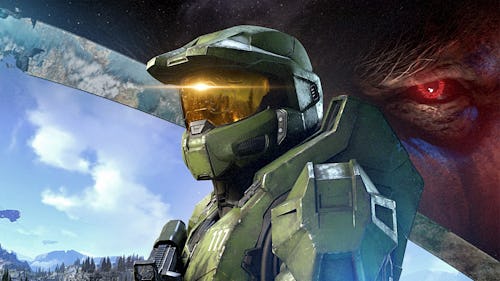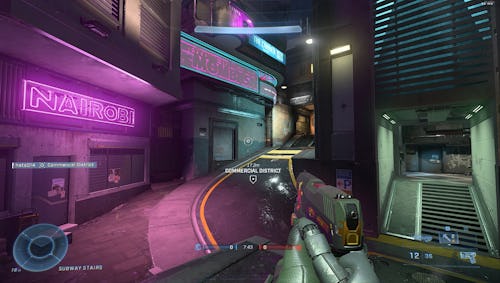
Top control. Open Street. Pink three. Bottom Glass. B Steps. Needle Pit. Needle Pit. Needle Pit.
No, these aren’t Radiohead lyrics. They’re “callouts” from the Halo franchise — identifiers used to describe digital locations around the game’s multiplayer maps. Callouts are an integral part of the genre used to describe the location of enemies or other points of interest in an arena. Communicating efficiently with teammates to track where the action is occurring is a fundamental skill to any team shooter. But when a new game, like Halo Infinite, gets released, its community has to decide how to name these various regions of digital real estate. There’s no official voting system or reference book to guide the process. Names emerge organically, born of convenience, intuition, and the whims of pro players.
The evolution of language in this newest Halo game has been fascinating to watch. Since its release in early November, the community has quickly settled into a (mostly) standardized system for describing the virtual world around them. At this point, nearly every corner, ledge, box, hallway, and room of the digital space has been assigned a callout. Due to a convergence of factors, this iteration of the game seems to have the most universal, standardized language of any Halo title to date.
An existing framework
A lot of the rapid standardization can be explained by legacy. This is seventh game in the Halo FPS line, so many of the conventions in the nomenclature are well established at this point, providing a framework for the language of the latest installment. Numbers can be used to designate which floor of a structure players are talking about, for example. For two story areas, you can substitute “top” and “bottom.”
Symmetrical maps are usually color coded, helping users to differentiate between, say, yellow courtyard and blue courtyard. Color, in fact, remains one of the most common types of adjectives used in callouts. “Purple street” is, obviously, the purple street. “There’s this principle of least effort that operates across all walks of life, but especially when it comes to information exchange and information capture,” says Astrid Ensslin, a digital humanities scholar at the University of Alberta who studies video games. “That’s why the Google search window has always been the most successful one. You just have one field and that’s where you plunk your information.” Indeed, the callouts that stick tend to be the ones that most closely mirror what you might Google to describe that part of the map.

Once you understand the basics of this language you can begin to piece different concepts together. “She’s top mid going to sword.” “He’s running pink street to red courtyard.” “One shot tires to arcade.” This is the language of Halo. “In linguistics you call this a spatial deictic environment,” says Ensslin. “Which means that when they point at something through language, or sometimes through gesture, they know what they’re talking about. They’re sharing a visual-spatial environment.”
Stick with what you know
The callouts that stick tend to be short, immediately recognizable, and, if possible, similar to previous Halo games. The best ones require the minimum amount of brain processing power to reference and recall. “It’s mentally taxing trying to think of what you’re saying with a new game, so the default becomes staying with what you know,” says Professional Player Paul "SnakeBite" Duarte of the Los Angeles Sentinels.
“It’s mentally taxing trying to think of what you’re saying with a new game.”
One of the most absurd examples of “staying with what you know” is actually what inspired this article. There’s a new map in Halo Infinite called Aquarius. It’s a small, symmetrical arena map with indoor vertical farming aesthetics — a sci-fi laboratory setting. But a lot of the map looks similar, it lacks big obvious features in many places, and, since it's symmetrical, there is two of everything. It’s a tricky map to call out on. Or at least it was until someone pointed out that it was sort of similar to a very famous map from past Halo games called Midship. Immediately, I knew how to describe things using the same callouts from Midship.
Granted, these callouts make absolutely no sense if you can’t transpose the old map onto the new one. Suddenly I was describing a player in a cubby between two plant-filled terrariums as being “Pink one.” There is no pink in the new map’s color palette anywhere. But other players knew what I meant. It was easier for us to adapt an old mental model to a new situation than to build an entirely new one.
Pinging
For the first time in the game’s history, Halo Infinite introduced a system for pointing to places. Called “pinging,” the functionality lets players press a button on their controller that will displace a marker on whatever they're looking at and include a name for that place.
Previous Halo games have included developer-given names that displayed on the HUD depending on where you were standing — but never before has the game allowed you to reference a place so explicitly or point to an area with an in-game mechanic. This has certainly been helpful in standardizing the naming, but only to a point. As with previous versions of the game, the developer-given names are eschewed for more intuitive names whenever possible.

Imitate the ruling class
The pro scene has always had a major influence on the Halo community, but never before has this world been so visible and accessible to the average viewer. With the rise of streaming, especially Twitch, casual players can watch pros scrimmage and compete. They glean strategies and listen in on how the top players communicate. Streaming, probably more than anything, has accelerated the standardization of the callouts in the new game. “When you understand network theory, it’s obvious right? People who are the most connected, you know the boldest, biggest nodes in a network … they will be the opinion makers. In media theory we call them influencers,” says Ensslin.
“People who are the most connected … they will be the opinion makers.”
Streaming has even made it easier for pro teams to communicate with each other. “I’ve been a pro going back to 2009 and I’ve noticed a huge difference,” says Snakebite. “Even callouts between teams are way more standardized. It used to be really specific to your team because there was no Twitch. You didn’t hear what other people were saying. Compared to now, everyone kind of gets on the same page now unintentionally.”
Death of dialects
Even though Halo’s linguistic standardization has been massively convenient, it’s somewhat sad to think about losing all those unique dialects. Inside jokes still work their way into the communities, but much less frequently now. Back in the days of Halo 3, my friends and I had a slew of stupid inside joke callouts. We had a calls for “Tingle’s Tower” or “Jacques’ House” or “dumb gun.” We knew the difference between “shotgun depot” and “shotgun actual.” All of these terms are utterly meaningless to the community in general, but they’re memories we all share now — ones that are just ours and reminded us of a funny experience or a great round. In Infinite, we just call everything what everyone else calls everything.
As cool as it is to immediately share a language with a hundred thousand other players, Infinite’s comms feel a little sterile — like a corporate handbook or a company-wide memo. It seems like the old maps had more weird or funny callouts. “Nerd” and “Eli” on Midship, for instance. “Walshy” on the Pit. “Dildos” on Snowbound. “Froman” on Zanzibar. Maybe we’ll see Infinite’s language evolve over time, or maybe future maps will lend themselves to more interesting names, but for now the parlance seems to have chosen accessibility over levity.







